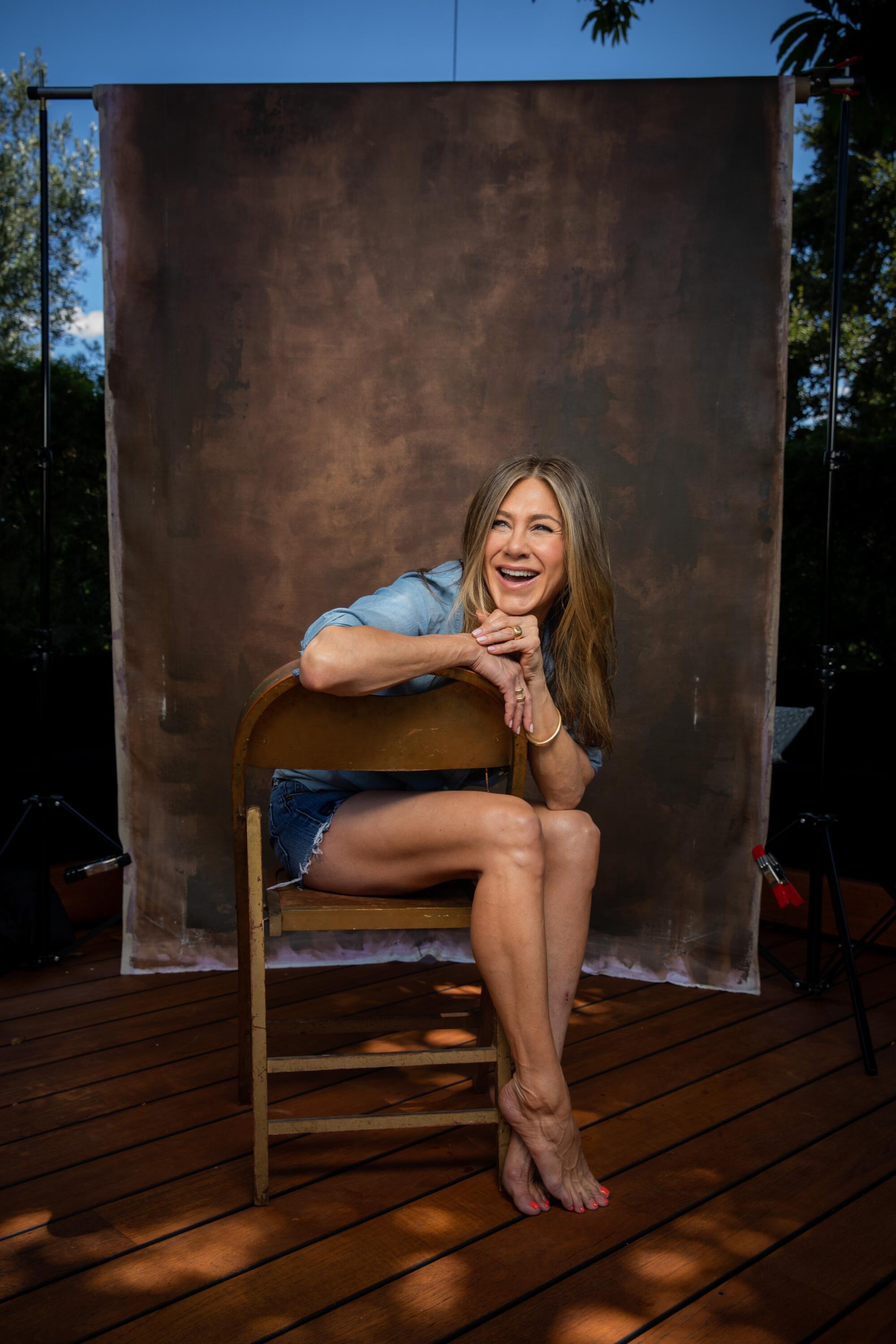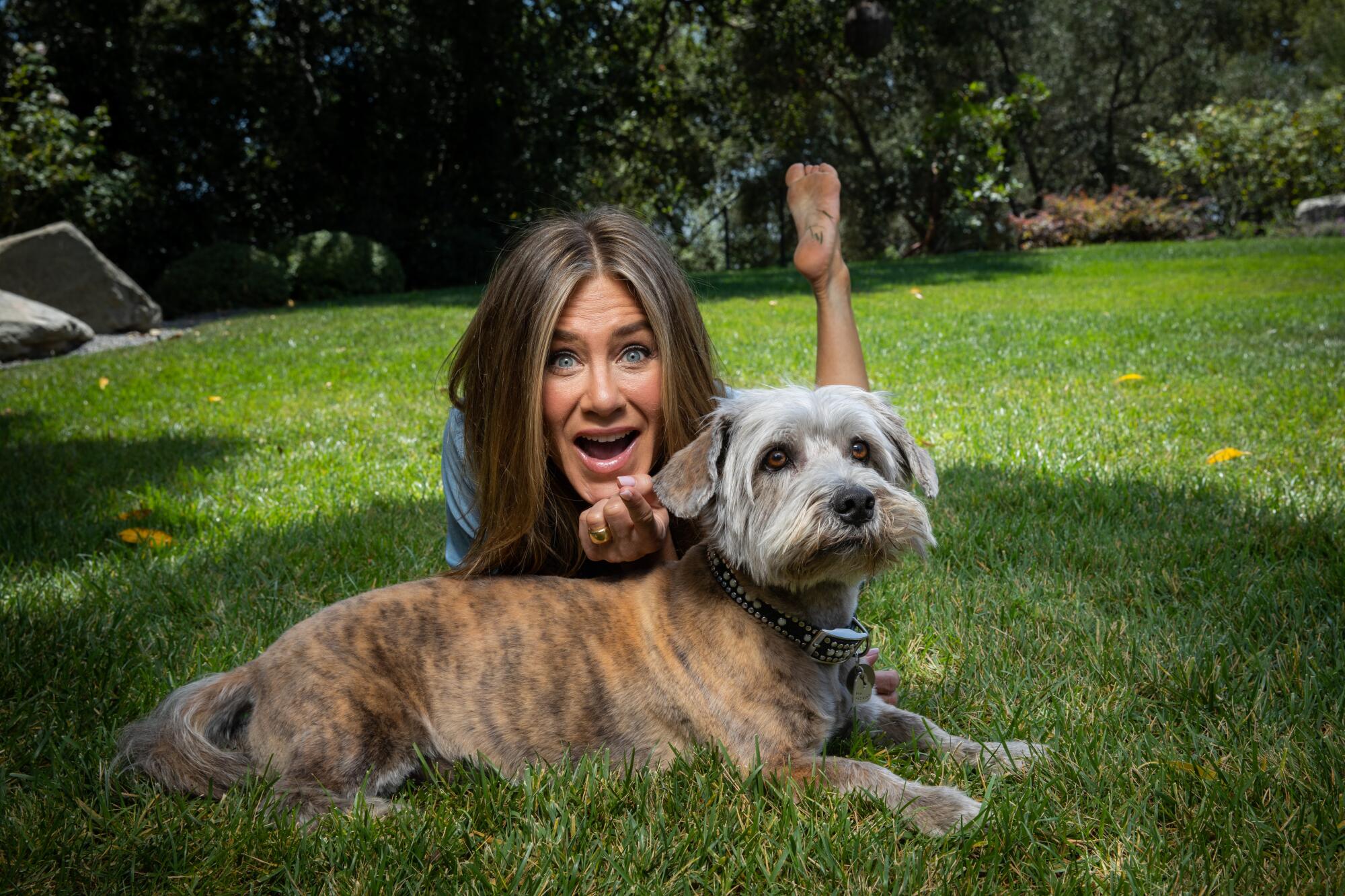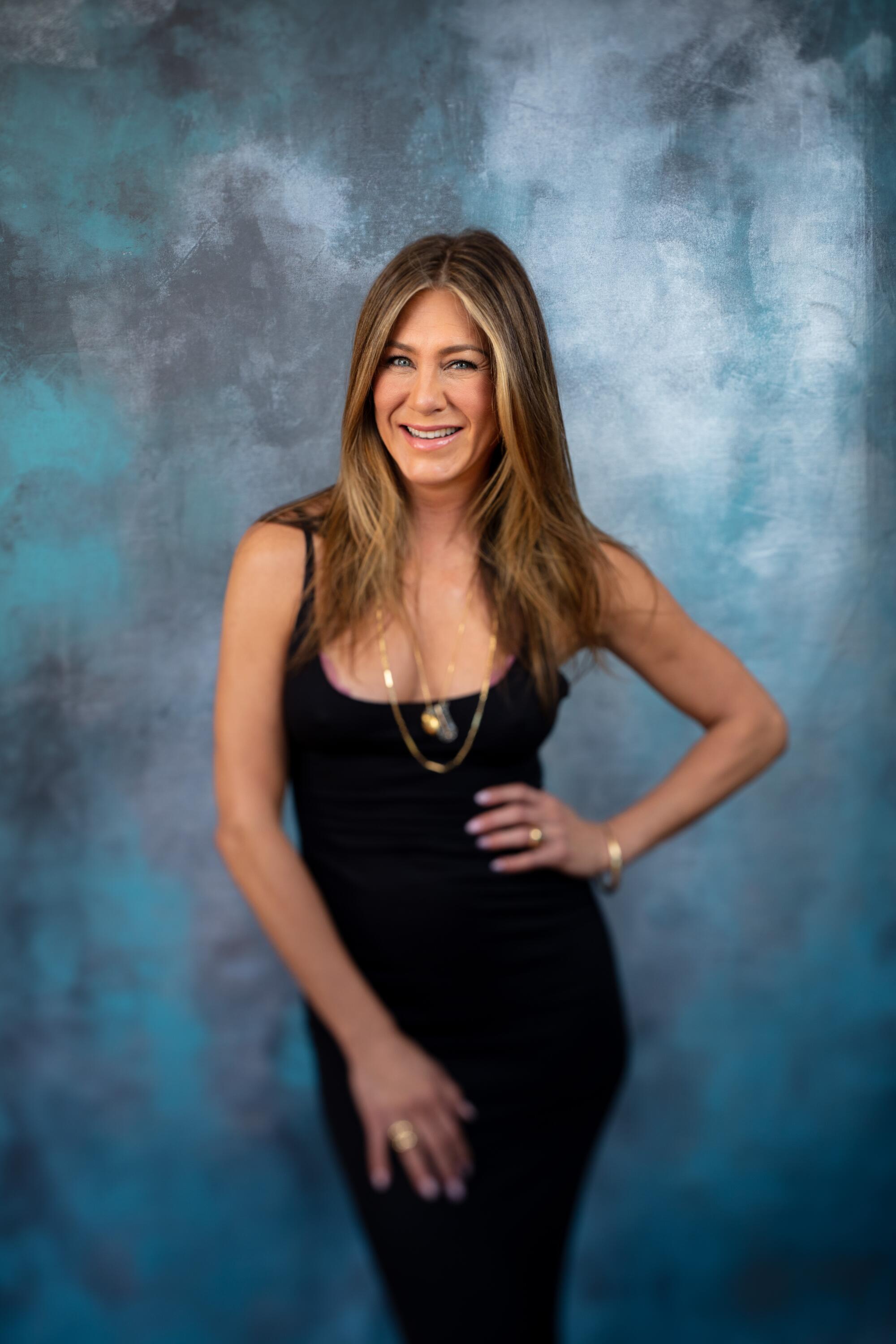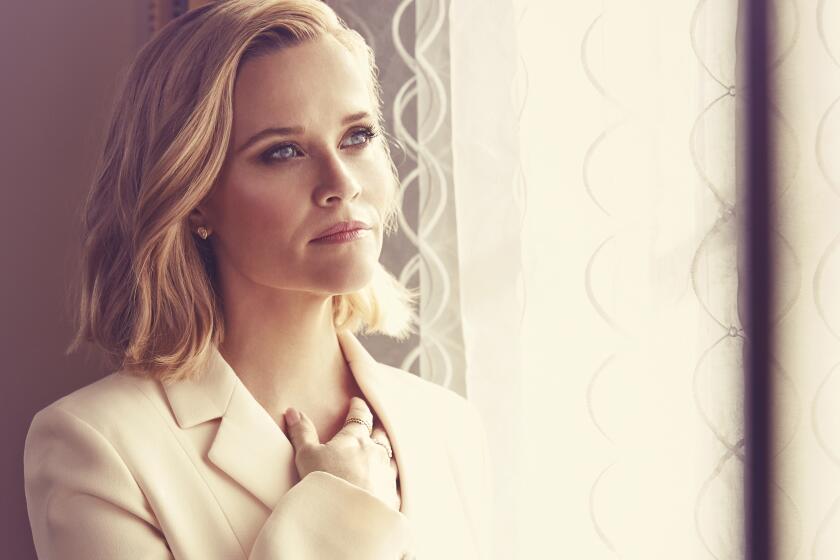
- Share via
Jennifer Aniston keeps a shoe box and a pair of gloves handy because ... well, it just happened again. A bird has flown into one of the glass windows of her midcentury Bel-Air home, and Aniston is grabbing the makeshift rescue kit and heading outside. “Oh, honey. Hi, little guy. She’s struggling and she can’t get up.” There’s a pause. “I’m so sorry. Can you hold on a moment?” Aniston mutes our call, returning in five minutes. “We did it, Glenn. We saved him. He might need a wing check, but I think he’s going to be OK.”
That Aniston has what she calls a “Dr. Dolittle plan” for the wayward birds in her life surprises exactly no one who knows her. Just before the moment of bird distress, Aniston was peppering me with questions about exercise, hydration and mental and physical well-being. “I love that she’s interviewing you about your health regime,” Kristin Hahn, Aniston’s longtime friend and producing partner, says a couple of days later. “That sounds about right. If you give this woman a problem to solve, she will spend whatever time it takes to come up with a plan and tell you how to deal with it. And I mean, any kind of problem. We call her Dr. Aniston.”
Aniston solved the primary problem of her own career — how to find a role that would challenge her in ways she could never expect and make the public not exactly forget that she played Rachel on “Friends,” because that beloved sitcom isn’t going anywhere in our lifetime, but at least showcase her talent in a way that might surprise people. Aniston’s turn as network morning anchor Alex Levy on “The Morning Show,” the flagship series in the Apple TV+ streaming lineup, did just that, earning Aniston the best reviews of her career, an Emmy nomination and a SAG Award in January.
“That show was 20 years of therapy wrapped into 10 episodes,” says Aniston, 51. “There were times when I would read a scene and feel like a whole manhole cover was taken off my back.”
You might guess that Aniston could relate to playing a famous woman whose every move is scrutinized and judged, who grapples daily with people projecting their ideas of what her life should be (Brad & Jen-aissance) versus the authentic journey she’s trying to forge, whose sell-by date “expired years ago” (at least, according to Billy Crudup’s dismissive network exec) and who, in one of “The Morning Show’s” most memorable scenes, tells her bosses that she’s really, really tired of being underestimated.
“Uh-huh,” she says, employing the comic timing she honed during a decade on “Friends” and innumerable movie rom-coms. “I see where you’re going.”
And she gladly goes there with me. “The Morning Show,” which she helped build from the ground up as a producer, felt like a two-year cleanse that forced Aniston to examine how she’s handled fame over the last three decades and decide that she could improve it.

“Cathartic, yes, and also interesting for me to look at how I always have tried to normalize being fine and ‘everything’s great, you know, this is all normal,’ and then there are moments when you have your private breakdown or your ‘Calgon, take me away’ moments,” Aniston says. “To actually look at it from an actor brain observing it and acknowledging it, I had to look at it as opposed to pretending it doesn’t exist.”
Showrunner Kerry Ehrin took the helm of Apple’s “The Morning Show” after it was underway — and decided to make #MeToo central to the story.
Aniston then dives into the scene in “The Morning Show’s” second episode where Alex melts down in a limo on the way to an industry awards event being held in her honor. Ostensibly, the anger stems from the impracticality of the tiny purses women carry down the red carpet. But it’s really about her anxiety over having to put on a happy face during a time when she’d rather be hiding under the covers. Aniston is utterly convincing in the moment, raw, empathetic and, of course, funny, when she turns on a dime at the onset of tears and sobs, “Oh, Jesus, I can’t cry!” because it would ruin the makeup her stylist had spent hours applying.
“There have been moments — not to that level of hysteria — but moments of ‘I don’t want to f—ing go here,’ ‘I don’t want to walk out onto the carpet,’ ‘I don’t want to be seen,’ ‘I don’t want to be looked at and everyone’s going to be talking about me and judging me’ ... that’s real,” Aniston says. “I just loved being able to walk into it and lean into it and not be ashamed of it, but actually just ... it was like ...” she lets out a sound of sublime satisfaction. “Ooooooooooh.”
There were times during the series’ first season when “Morning Show” showrunner Kerry Ehrin would check in and ask Aniston: Are we pushing it? Are we taking it too far? And Aniston would answer that it was never too far. Keep it coming.
“I do think I glean emotional structure from people,” Ehrin says, “and after spending time with her, I felt certain instincts about writing the character. And it’s hard to say whether that comes from a conversation or something I saw 20 years ago that she did.”
Unlike the entitled woman she played on the Hulu limited series “Little Fires Everywhere,” Witherspoon possesses a self-awareness about her privilege and position, knowledge forged through 30 years of working in Hollywood.
Says Hahn: “I was so moved to tears so many times, just watching behind the monitor and brought to tears at the level of bravery of being that truthful. I know her well enough to know when she’s being concerned about what other people think, and she just let everything go. She exorcised a lot of conflict through this character.”
“The Morning Show” had begun filming its second season earlier this year before COVID-19 shut down production in March. Aniston says the break proved fortuitous, because it allowed them to incorporate the pandemic into the story and reflect the unease everyone felt when they were shooting the season’s first two episodes. Pre-COVID and post-COVID are different universes, Ehrin says, and there’s no way a topical program like “The Morning Show” could ignore that. What will that look like? “You’re just taking the best guess of what you think will be an effective place to go with the storytelling and let the characters guide you,” Ehrin says.

Aniston’s post-COVID-19 life looks like this right now: She has a “bubble” of four families that rotate among their homes and never go outside the pod. The kids have grown up together and know one another, so they have a good time, and “it’s all lovely,” Aniston says. She’s reading, watching a ton of TV, veering between things like “Queer Eye for the Straight Guy” and the James Baldwin-centered examination of American racism, “I Am Not Your Negro.” And “Lenox Hill,” the Netflix medical docuseries, because Aniston was addicted to “Trauma: Life in the E.R.” back in the day and loves watching the stories of doctors and healthcare workers, particularly at this moment in time.
Last summer and into the early fall, Aniston hosted a series of salons, “Jen Talks,” she calls them, inviting a few dozen friends to her home to listen to people like Jessica Yellin discuss politics or Jay Shetty distill what he learned as a monk or David Sinclair offer advice on longevity. Because Aniston has her eye on the long game. And she plans on winning.

“I look at my dad, who just turned 87, and he is Greek — stubborn, fabulous, all those things from that generation — but, you know, I think they could be a little healthier. He’s going to be so mad at me.” Aniston pauses, laughing. But she’s not stopping. “You know, my mom, c’mon, none of you guys took care of yourselves. But they didn’t know any better. And now we know. So what’s our excuse? It’s about just knowing what you put inside your body, exercising — my father, never, ever — they didn’t know you could keep your bones strong, never mind being fit and fitting into a size-whatever.”
“I’m going to be in my 80s or 90s or maybe now even my 100s at this rate,” Aniston continues, “and I don’t want to be wheeling around. I would like to be vibrant and thriving.”
And we talk more about bone density and cellular regeneration and how 90 might soon be the new 70 and about a “new level of consciousness that’s getting birthed right now” and planetary alignment and how these troubling times are temporary and “this too shall pass” and then our time together is done. But not before Dr. Aniston leaves me with one last prescription: “Rich Roll podcast. David Sinclair. Longevity.” It’s 2½ hours long. And I have a bad feeling I’m going to be giving up pasta after I finish listening to it.
More to Read
The complete guide to home viewing
Get Screen Gab for everything about the TV shows and streaming movies everyone’s talking about.
You may occasionally receive promotional content from the Los Angeles Times.









